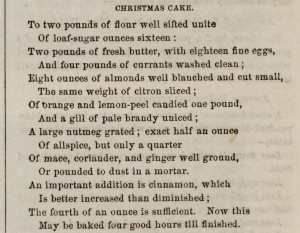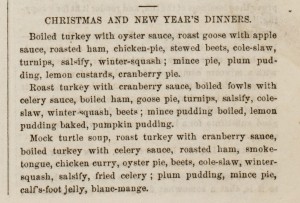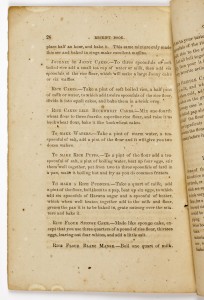We are going to brave the waters of wartime Christmas. In the next few days, there will be three posts examining Confederate-printed items in the Society’s collection. This season of festivities is also one of commemoration and reflection as we are squarely in the War’s sesquicentennial.

A glance over the pages of the nation’s most popular ladies’ magazine in the 1860s would suggest that (in the culinary sphere) all was well a year and a half into the Civil War. The recipe for “Christmas Cake” printed in Godey’s 150 years ago this month, requires no less than two pounds of flour, two pounds of fresh butter, four pounds of currants, eighteen eggs, eight ounces of almonds, eight ounces citron, candied orange and lemon-peel, brandy, nutmeg, allspice (but only a quarter), mace, coriander, ginger and cinnamon and sixteen ounces sugar. There are also recipes for Fruit Cake, Washington Cake, Queen Cake, Gingerbread and Lemon cake; no recipe was too rich, no dessert too sweet or spiced. In short, the Christmas recipes are not ones stressing the country’s-cook to have a tightened belt or be economy-savvy in the kitchen.

The December 1862 Godey’s tells a distinctive and seemingly unfazed Christmas food story. Sarah Josepha Hale’s publication shows a diversity of options – large numbers of puddings, pies, cakes and even a suggested menu for Christmas that “will be of great use to our lady friends during the Christmas holidays.” There is little talk of deductions (to say nothing of other ways to create a traditional recipe); there is neither rationing nor substituting. Though Godey’s notably had appeal to both Northern and Southern women in the 1860s, a book like The Confederate Receipt Book, which is subtitled “adapted to the times” reflects another take on wartime-eating.

The text, a tightly-bound 28-page imprint, wrapped in dotted-wallpaper was printed by West & Johnson of Richmond, Virginia in 1863. The pamphlet, as the publishers’ advertisementindicates, is designed to supply “useful and economical directions and suggestions in cookery, housewifery, &c, and for the camp.” In the culinary section alone, the recipes evidence food shortages. Any romantic idea we might have had about the South celebrating the holidays with luxurious plantation balls and dinner parties would vanish with just a cursory glance at this wartime imprint.
The Confederate Receipt Book provides information on making ‘Confederate’ candles, medicinal remedies, directions on how to dry herbs, substitutions for coffee and cream, in addition to inventive culinary tips including how to rise bread without yeast and how to
make apple pie without apples. There is also an appendix with an 1862 note by Elizabeth Lewis discussing rice flour and its substitutive abilities. The closest I could find to a “Christmas Cake” was in this section, Rice Flour Sponge Cake. The two publications reflect not only divided diets but scarceness (or availability) of resources in 1862-3. Indeed, both tell vastly different culinary stories.

Few facsimiles are available of the item and whereas every piece of information is valuable in this slim pamphlet, it was digitized in full; it is available here.
Think of it as our gift to you.
For more information on the Confederate cookbook:
Burroughs, Frances M. “The Confederate Receipt Book: A Study in Food Substitution in the American Civil War.” In South Carolina Historical & Genealogical Magazine 93 (January 1992). p. 31-50.

One thought on “Christmas Cooking, North & South – 150 years ago”